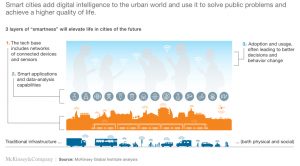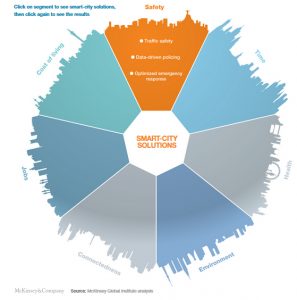As cities get smarter, they are becoming more livable and more responsive—and today we are seeing only a preview of what technology could eventually do in the urban environment.
Until recently, city leaders thought of smart technologies primarily as tools for becoming more efficient behind the scenes. Now technology is being injected more directly into the lives of residents. Smartphones have become the keys to the city, putting instant information about transit, traffic, health services, safety alerts, and community news into millions of hands.
After a decade of trial and error, municipal leaders are realizing that smart-city strategies start with people, not technology. “Smartness” is not just about installing digital interfaces in traditional infrastructure or streamlining city operations. It is also about using technology and data purposefully to make better decisions and deliver a better quality of life.
Quality of life has many dimensions, from the air residents breathe to how safe they feel walking the streets. The latest report from the McKinsey Global Institute (MGI), Smart cities: Digital solutions for a more livable future (PDF–6MB), analyzes how dozens of digital applications address these kinds of practical and very human concerns. It finds that cities can use smart technologies to improve some key quality-of-life indicators by 10 to 30 percent—numbers that translate into lives saved, fewer crime incidents, shorter commutes, a reduced health burden, and carbon emissions averted.
- What makes a city smart?
- Smart-city technologies have substantial unrealized potential to improve the urban quality of life
- A look at current deployment in 50 cities around the world shows that even the most advanced still have a long way to go
- Smart cities change the economics of infrastructure and create room for partnerships and private-sector participation
What makes a city smart? Smart cities put data and digital technology to work to make better decisions and improve the quality of life. More comprehensive, real-time data gives agencies the ability to watch events as they unfold, understand how demand patterns are changing, and respond with faster and lower-cost solutions. Three layers work together to make a smart city hum. First is the technology base, which includes a critical mass of smartphones and sensors connected by high-speed communication networks. The second layer consists of specific applications. Translating raw data into alerts, insight, and action requires the right tools, and this is where technology providers and app developers come in. The third layer is usage by cities, companies, and the public. Many applications succeed only if they are widely adopted and manage to change behavior. They encourage people to use transit during off-hours, to change routes, to use less energy and water and to do so at different times of day, and to reduce strains on the healthcare system through preventive self-care.
…
By Jonathan Woetzel, Jaana Remes, Brodie Boland, Katrina Lv, Suveer Sinha, Gernot Strube, John Means, Jonathan Law, Andres Cadena, and Valerie von der Tann
More: https://www.mckinsey.com

